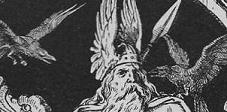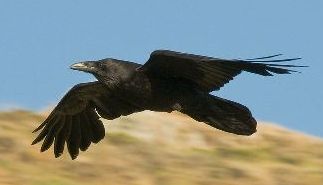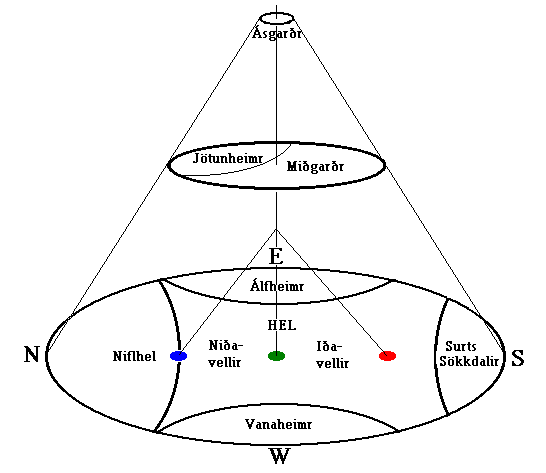The Poetic Edda: A Study Guide
The Speech of the Masked One

[PREVIOUS][MAIN][NEXT]
[HOME]
MS No. 2365 4to [R]
AM 748 I 4to [A]
Normalized Text:
20. Huginn ok Munin
fljúga hverjan dag
Jörmungrund yfir;
óumc ek of Hugin
at hann aftr né comiþ,
þó siámc meir um Munin.
20. Huginn ok Muninn
fljúga hverjan dag
Jörmungrund yfir;
óumz ek of Hugin
at hann aftr né komi,
þó siámz ek meir um Muninn.
20. Huginn ok Muninn
fljúga hverjan dag
Jörmungrund yfir;
óumk ek of Hugin
at hann aftr né komit,
þó sjámk meir um Munin.
in Icelandic Poetry
“The Song of Grimnir”
The Yale Magazine, Vol. 16
“The Song of Grimner”
XX. Hugo, in azure fields of air,
And Mumin too each day appear:
I fear lest Hugo safe return,
But more for Mumin inly mourn.
Hug-inn and Muninn, over the fields of earth
Fly daily; fear creepeth upon my soul,
Of Huginn, lest he come not faithfully;
But of Muninu I have greater fear than this.
in Edda Sæmundar Hinns Frôða
“The Lay of Grimnir”
in Corpus Poeticum Boreale
“The Sayings of the Hooded One”
20. Hugin and Munin
fly each day
over the spacious earth.
I fear for Hugin,
that he come not back,
yet more anxious am I for Munin.
Thought and Mind [his two Ravens] fly every day over the
mighty earth :
I fear for Thought lest he never come back, but I am still more fearful about
Mind. . . .
in Edda Saemundar
“The Sayings of Grimnir”
in The Poetic Edda
“Grimnismol: The Ballad of Grimnir”
Out of Sequence:
24. Ravens, Hugin and Munin, of Thought and Memory
wing the wide world each day :
I tremble for Thought, lest he come not again,
yet for Memory more I fear.
20. O’er Mithgarth Hugin and Munin both
Each day set forth to fly;
For Hugin I fear lest he come not home,
But for Munin my care is more.
20. Mithgarth - 'Middle home'. Hugin - 'Thought', Munin -
'Memory'.
in The Poetic Edda
“The Lay of Grimnir”
in The Elder Edda
“The Lay of Grimnir”
20. The whole earth over, every day,
hover Hugin and Munin;31
I dread lest Hugin droop in his flight,
yet I fear me still more for Munin.
31
"Thought" and "Remembrance," Othin's ravens which bring him intelligence.
Thought and Memory each morning fly
Over the vast earth:
Thought, I fear, may fail to return,
But I fear more for Memory.
in The Poetic Edda
“Grimnir’s Sayings”
in The Poetic Edda, Vol. III: Mythological Poems
“The Lay of Grimnir”
20. Hugin and Munin fly every day
Over the wide world;
I fear for Hugin that he will not come back,
Yet I tremble more for Munin.
make their flight every day
over the limitless land.
For Mind I fear
he may not come back,
though I am more anxious for
Heart.
The Elder Edda: A Book of Viking Lore
'The Lay of Grimnir"
20. Hugin and Munin fly every day
across the Gaping Ground.
I worry that Hugin may not return,
but I am more worried about Munin.

[HOME][GRÍMNISMÁL]

"Snorri (Gylfaginning 38) explains that Hugin ('Thought') and Munin ('Memory') are Odin's ravens. It is, of course, ironic that the aged Odin worries more about losing the latter one."
"Hugin and Munin: Odin's ravens. Their names mean 'Thought' and 'Memory' and they are also mentioned in Ynglingasaga 7.
Ynglingasaga 7: Hann átti hrafna tvo er hann hafði tamið við mál. Flugu þeir víða um lönd og sögðu honum mörg tíðindi; "He owned two ravens, which he had taught to talk; they flew far over the land and told many tidings." (Erling Monsen tr.).
'Runes' by Patrick Larsson in A Companion to Old Norse-Icelandic Literature and Culture, edited by Rory McTurk, 2005:
"Almost as well known as the Rök stone is the rune stone from Karlevi on the island of Öland (Öl 1: DR 411). This is due to the fact that the stone provides the oldest record we have of the skaldic metre dróttkvætt— and not just a few lines, but a complete stanza.
"...In the case of the Karlevi stanza, we see that the phrase Endils iörmungrundar reið-Viðurr, the overall meaning of which is 'leader, chieftain'. Endill is the name of a sea-king, while iörmungrund f. means 'mighty ground', 'vast expanse'; 'the mighty ground of the sea-king' is thus a kenning for 'sea'. Óðinn is known by many names, one of them is Viðurr, and reið- means 'wagon-'. The god of a wagon used at sea, that is, a ship, thus gives the meaning 'leader, chieftain'.
"...Interesting also is the fact that some of the words in the stanza are well known in eddic and skaldic poetry, some even in non-Scandinavian sources. For instance iörmungrund f. 'mighty ground', 'vast expanse', is recorded not only in the eddic poem Grímnismál, where we learn that Huginn and Muninn, Óðinn's ravens, flúga hverian dag i iörmungrund yfir, 'fly each day over the earth's wide surface' (Grm. st. 20), but also in Beowulf (l. 859: eormungrund). This seems to suggest that the early poetic language was to a certain extent common currency, not only in Scandinavia, but also in some other Germanic-speaking areas."
1851 C.P. in The Yale Magazine: the fields of earth
1866 Benjamin Thorpe: the spacious earth
1883 Gudbrand Vigfusson: the mighty earth
1908 Olive Bray: the wide world
1923 Henry Bellows: Mithgarth
1962 Lee M. Hollander: the whole earth
1967 W. H. Auden & P. B Taylor : the vast earth
The three most recent translations are more ambiguous:
1996 Carolyne Larrington: the wide world
2011 Ursula Dronke: limitless land
2011 Andy Orchard: Gaping Ground
According to the Cleasby/Vigfusson Dictionary, the prefix jörmun- appears in a few mythical words, implying something huge, vast or superhuman. Examples include Jörmungand, the world-serpent and Jörmunrekr (i.e. Eormenric) a mythical ruler. The definition earth is supported by Anglo-Saxon eormengrund in Beowulf 859, where it means “earth.”
In this verse, Odin seems to say that he sends his ravens out each day over the wide earth. The verse does not tell us why. Snorri quotes the verse and informs us that it is to gather news, as they tell him what they see and hear. Odin worries for them both, but for losing Munin (memory) he fears more.
Why would Odin, who has a throne at the apex of the heavens, from which he can observe everything going on in the world fear losing track of his ravens? Theoretically, he could see them wherever they went. And, why would he need to send them out in the first place, if he can see what is going on for himself?

Jörmungrund
|
Jörmungrundar |
At Jörmungrund's northern border, under the outermost root of the noble tree, went to their couches giantesses and giants, dead men, dwarves, and dark-elves. |
Both Grímnismál 31 and Snorri’s Edda inform us that the world-tree has three roots, each one associated with a well. One root is associated with the well Hvergelmir. According to Snorri, Hvergelmir is located in the north, in Niflheim. Thus, the northernmost of the tree is located in Niflheim. This corresponds to the type of beings that Hrafnagaldur Odins tells us reside there: ogresses, thusrar, dark-elves and dead men. Thus Jörmungrund is not the earth, the home of living men, but the northern part of the underworld, the home of dead men and demons, and other creatures of the dark such as dark-elves and dwarves.
How can this be? What is meant by “the great ground” if not earth? Might it be the underworld, upon which the upper worlds rest?
Snorri informs us that in the beginning, there already existed two worlds: a world of fire to the south and a world of ice to the north. Between them stood a yawning chasm. Floes from both worlds streamed into the abyss creating new life, and filling in the gap. In the midst of the gap Ymir grew. In time, Odin and his brothers slew the giant and made Midgard from his corpse.
Völuspá 4 and 17 refer to Midgard as a building (sal, 'hall' and hús, 'house' respectively) allowing us to see the upper worlds as a construct resting on the original world. The poem Hrafnagaldur Óðins calls this foundation Jörmungrund, the great ground. Naturally, it is larger than Midgard, the world above it.
Since we know from several sources that Odin has a throne, Hliðskjálf, from which he can see over the entire world, the purpose of the ravens and Odin's fear of losing track of them defies logic. Whatever they see and wherever they go, Odin could also see from his throne. However, when we recognize that Old Norse cosmology consists of a three-tiered system with Asgard at the top, Niflhel/Hel at the base, and Midgard in the midst of them, this statement makes perfect sense. Since Midgard (Tolkien's 'Middle-Earth) lies in between heaven and Hel, the disc of the earth blocks the regions below from Odin's view. Beacsue of this, he cannot see what occurs beneath Midgard from his throne in the sky. Thus he employs the ravens, Hugin and Munin, to spy there. Hugin and Munin, literally 'Thought' and 'Memory' fly over the realm that Mimir rules. It is probably no coincidence that Mimir's name also derives from a root meaning "memory."
[PREVIOUS][MAIN][NEXT]
[HOME]